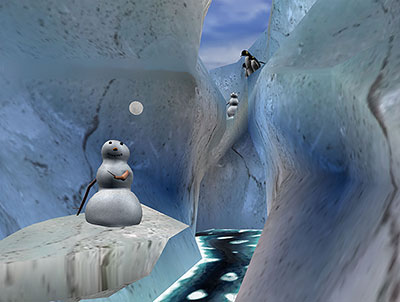
You glide across an icy canyon where you meet smiling snowmen, waddling penguins and a glistening river that winds forever. You toss snowballs, hear them smash against igloos, then watch them explode in vibrant colors.
Back in the real world, a dentist digs around your mouth to remove an impacted tooth, a procedure that really, really hurts. Could experiencing a “virtual” world distract you from the pain? NIGMS grantees David Patterson and Hunter Hoffman show it can.
Patterson, a psychologist at the University of Washington (UW) in Seattle, and Hoffman, a UW cognitive psychologist, helped create the virtual reality program “Snow World” in an effort to reduce excessive pain experienced by burn patients. However, the researchers expect Snow World to help alleviate all kinds of pain, including pain experienced during dental procedures.
To find out if life in Snow World really is painless, the scientists worked with healthy undergraduate student volunteers. One group of students were given immersive virtual reality (VR) glasses and a wireless mouse that enabled them to directly interact with the wintry environment. A second group of students received a passive VR system that included glasses but no wireless mouse. They saw the snowy world as if watching a movie, unable to go ice skating, make a snowball or pat a penguin. The researchers exposed both groups of students to brief periods of painful, but tolerable, heat both before and during their virtual reality experiences, and then measured their perception of pain.
Sure enough, even though all the students were exposed to an identical amount of heat, the ones fully immersed in the interactive virtual reality world reported 75 percent less pain than those in the non-interactive world. Our minds can focus on just a few things at once, the researchers say, so if we’re busy building igloos and making friends with snowmen, we have less brainpower available to register the heat on our bodies or the twang in our tooth.
Patterson and his team also have encouraging results reducing pain in pediatric burn patients using next generation VR goggles.
In addition, the team recently began testing augmented reality to promote movement in children with leg and foot burns. Movement facilitates healing of the skin, prevents muscle atrophy and promotes mental health. Specifically, the researchers are using Pokemon Go to motivate young patients to walk around the hospital (with close supervision) and capture Pokemon characters. The team is currently pursuing formal clinical trials.
While virtual environments can have drawbacks—like motion sickness, for one—they offer a promising new way to manage pain during medical or dental procedures. And, as recent research shows, reducing pain can speed recovery. Now that’s a relief!
This work was funded in part by NIH under grant R01GM042725.
Learn more:
David Patterson’s Profile on Biomedical Beat


As a healthcare provider who has both experienced significant acute pain and cared for patients with mental health challenges related to chronic pain, I am a real believer in the ability of distraction to alleviate pain. My pain distraction was watching comedy movies. It was able to distract me from pain that narcotics barely touched. I personally think the idea of an icy beautiful world to interact with to alleviate pain in burn patients (which is pain that most of us are fortunately unable to even imagine) is a stroke of pure genius. I wish you every success in your continued research. Is there somewhere that we health care professionals can get a glimpse of the experience of this (literally) cool virtual world in motion?
Now that’s using the dollars wisely, anything that helps alleviate any discomfort in humans is alright with me.
HI, Thanks for sharing your informative and amazing post, I hope everyone will be benefited if they read all of your post. Please write more for us as we learn more.
thanks again,
Take Care.
This article was really great to read. I’m just seeing this for the first time in February 2018, and it was posted in July, 2016. This is called the Biomedical Beat blog, follow the process of discovery. Following the process of discovery kind of means following each of the blogs that are in process. Are these specific blog items continually modified as progress goes on, so that we can read their updates?? The three posts above where just from a few months after this was posted. Thank you very much. 🙂
Hi Claude, Thanks for the thoughtful question. We do try to provide updates on the posts we write. For example, over the years we’ve written about multiple stages of the research of one of our prominent scientists, Dr. Kevin Tracey. We’ve written about his work in bioelectronic medicine and his work trying to understand deadly sepsis infections. We’ve also recently filmed a video interview with Dr. Tracey in which he discusses new findings related to these topics. Watch for it in the coming weeks.
Informative post, I think the most popular theory is that VR effectively competes for a large fraction of a user’s fixed amount of conscious attention, distracting the user’s focus away from simultaneous nociceptive input from a painful medical procedure and replacing it with more pleasant sensory input from the virtual experience.